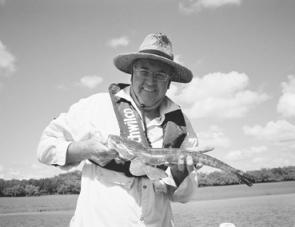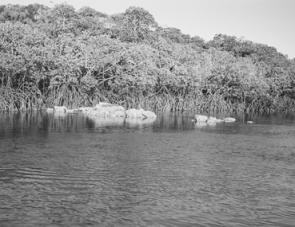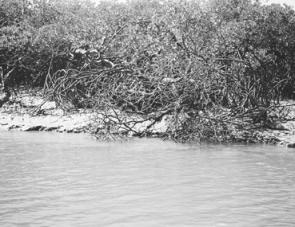The so called ‘grey brigade’ know a thing or two about life, heading north each winter to get away from the cold and enjoy a little bit of sunshine in the tropics. Many of these elderly Gypsies are anglers too and they know this is a good time of year to be fishing in the north.
Up here we enjoy great weather during the winter with very little wind, daily temperatures in the mid to high teens and plenty of sunshine. What more could you ask for? Apart from good fishing of course. So much is written about barra fishing in the north that readers could be forgiven for thinking that is all we have, and everyone knows barra are definitely not at their best during the winter. But don’t worry there are plenty of other opportunities for anglers in the creeks and offshore.
I’m going to focus on what to expect in the creeks this month and then I will concentrate on the offshore scene next time.
I guess the first information that a visitor needs is where to go. I recommend a great little spot just north of Mackay that will give you a great number of angling opportunities in the winter sun.
Seaforth is one of Mackay’s top little playgrounds about 45 minutes drive north from the city turning off the Bruce Highway at The Leap. Follow the bitumen road right through to the beachfront. Here you will find fuel, supplies, a Post Office, bait, ice and plenty of locals who will give you a few pointers.
There is a well maintained camping area under the gums and right on the beach with basic amenities. The area has reasonable rates. The camping area is run by the Mackay City Council and bookings can be made through them before you arrive in Mackay. If you arrive without a prior booking, I suggest you contact one of the local shops and they will give you contact numbers. This would be a good time to buy a few supplies and get some local information on what’s biting where.
There are also several units available but these are fairly popular, so I suggest contacting the Seaforth store first up or do some internet searching before heading north. Alternatively, stay in Mackay where there is plenty of accommodation and travel back and forwards to do your fishing. The only trouble is that the fishing is so good around Mackay you may not make it to Seaforth!
Once you have your camp sorted it is time to start fishing. So where should you go? If you like a feed of whiting, flathead or the occasional grunter and bream head down to the beach. All you need to do is fish the beach front as the tide comes in with fresh yabbies or a lure and you will score yourself a feed that way. How good is that?
I suggest working the beach from the park southwards to the mouth of Seaforth Creek. There are some interesting gutters along here and near the creek there are a few mangroves out by themselves. Remember if you are wading to be aware of stingers and wear some long trousers and shoes as protection. Check with the local shops for the current information on stingers.
The water is clean and clear and although there are crocodiles and sharks in the area, these are very rarely seen along the beach. Like most of the district beaches, this one is shallow and slopes gradually.
Yabbies are the best bait, followed by fresh prawns or worms. I think the best beach lures are small and shiny like a Pegron or a small minnow such as a Little Lucifer or a Fat Rap.
If beach fishing isn’t your scene and you like getting out in a small boat and up the mangrove creeks then there is plenty of scope for your activities. The main multi-lane, all-tide boat ramp is a few kilometres away at Victor Creek with a good parking area. It does get congested at times so a bit of patience, courtesy and prior preparation will see things go smoothly.
If you don’t want to go with the crowds, then Seaforth Creek, which is a small system just south of town, is worth exploring. Launching is done over sand at the mouth so be careful and get some local advice first. This little system has some very interesting rock formations as well as mangroves and fishes well for cod, bream and jacks.
Most anglers though use Victor Creek or head off into Clunies or Canoe creeks whilst some venture further up to the Murray and St Helens creeks areas. This article will focus on close handy creeks that are similar in type and length, although Victor is shorter than the others.
Be aware that crocs are regularly seen near the boat ramp and just upstream, so although there is no history of problems, just keep them in mind.
All three of these creeks get quite low on the bottom of the tide and this restricts movement in the creeks and access into or out of Clunies and Canoe in particular. Victor has a marked channel providing offshore access at all stages of the tide, but the others are best accessed with at least half a making tide.
These creeks are all mangrove lined with a mix of mud, sand and gravel bottoms. All have good patches of healthy mangroves and rockbars so just be a bit careful and get some local advice so you are not on a prop busting exercise.
The deeper channels and gutters are obvious places to look for fish at the lower stages of the tides and these are easily found even without a sounder. Fish back into these from shallower water as the tide falls and this is a prime spot for ambush artists like flathead. Cod and jacks can also be found in these deeper spots, particularly if there are rocks for cover.
Another hotspot on the falling tide is to fish small gullies that run out of the mangroves into the main creek. There are heaps of these spots in all the creeks and they are a good option to work as the tide falls. I often start at the top of the creek at the first of the run out and gradually work down stream as the tide falls. Off these little gullies flathead, fingermark, trevally and cod are commonly caught.
If you are targeting flathead, then any spot dropping into deeper water is worth a go. Don’t ignore muddy flats either as our flathead don’t mind lying in the mud. Sandy spots are always worth trying but these spots tend to be more towards the mouths of the creeks with mud the norm further upstream.
The falling tide spots are pretty easy to identify and are common all over the country. If it looks fishy then fish it is the best advice I can give to any visitor. Our big tidal movements sometimes put visitors off from trying their luck as the tide rises or at the top of the tide. Don’t ignore the possibilities here as there are a few tips that can help put a fish or two in the esky.
On the incoming tide species like flathead, trevally, queenfish, grunter and bream have a tendency to rove right up in the shallow water over the sand and mud flats. Again there are literally dozens of spots like this in these creeks and all are worth a try. This is one time when having an electric outboard is of great help as the water is very shallow and a petrol motor, even a 4-stroke will spook fish. This is also not the time to be banging things on the sides or bottom of the boat.
The go here is to be continually moving up with the tide over the flats and using very fresh baits, live if possible, or small lures. At the top of the tide there could be 1-2m of water over these flats and that is also a good time to be there.
Many of these flats have either lone or small clumps of mangroves growing on them. These are hot spots at the top of the tide and quite large fish can be found working these spots. Here we usually don’t find the ambush species, but are more likely to come across the rovers patrolling around the flats.
Expect fish like trevally, queenfish, barracuda, salmon and steelbacks in the cruisers and the foragers will be represented by the likes of grunter and bream. All of these can be caught in surprisingly shallow water, and be prepared for anything. It is not unusual to hook and sometimes land queenies and trevally to 8kg up on these flats, and when hooked they light up the afterburners and really get moving. In shallow water this makes for very exciting fishing.
I use both but have a preference for lurefishing as I find it more proactive and covers more spots. There are a number of must haves in my tackle box for wintersun luring and I would not go without these lures in my tackle box, Reidy’s Little Lucifer, Rapala 50 and 70mm Fat Raps, a popper or two, 100-120mm minnows in shallow and deep (stick with Aussie made as they are best), and some paddle tail and curly tail plastics.
Fly anglers should have some poppers, surf candies, deceivers and clousers in various colours and weights. Remember one of the most common baitfish is the small herring and just about anything will eat them.
For bait keep to the live or very fresh theme and you won’t go too far wrong. Bring a castnet for prawns and herring, and a yabby pump and you cover most bases and species.
Even though the winter months are not traditionally the top times for mudcrabs, a pot dropped in while fishing or a dilly that is shifted around with you may just get you a crab or two. But if they are very light floaters then don’t waste them. Return them straight away and let them fatten up for the summer.
So if you’re a frustrated southern angler who is sick of the cold weather and general lack of fish, hook up your tinnie and come and join us up here in paradise and enjoy some top angling in the winter sun.
Reads: 3194
During winter flathead become a popular target. They are found in all the typical flathead locations of sand bars, drop offs and draining gutters.

This is the type of habitat you can find in the smaller creeks around Mackay. Rock bars, snags and drains all hold fish at different stages of the tide and are well worth the effort finding and fishing.






